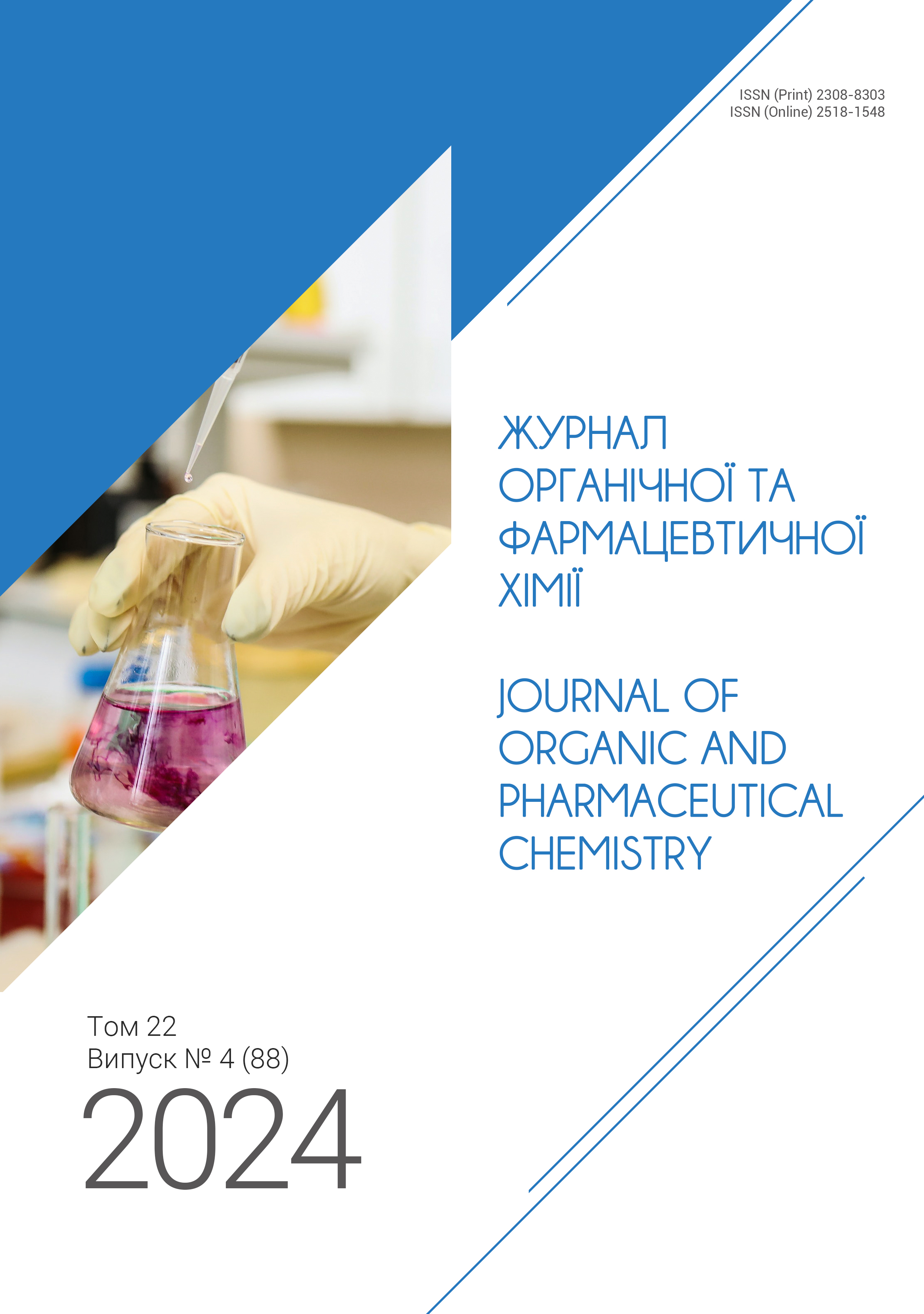The Use of Tetramethylbenzidine as an Indicator in the Enzymatic Quantitative Determination of Ethonium
DOI:
https://doi.org/10.24959/ophcj.24.321795Keywords:
ethonium, quaternary ammonium compounds, cholinesterase, acetylcholineAbstract
The study considers the possibility of using 3,3',5,5'-tetramethylbenzidine (TMB) as an indicator in the enzymatic analysis for the quantitative determination of quaternary ammonium compounds on the example of ethonium. The feasibility of using TMB as an indicator in the kinetic photometric method has been confirmed. Kinetic curves showing the relationship between the optical density and the ethonium concentration have been constructed. The reaction rates of acetylcholinesterase inhibition by ethonium have been estimated using the tangents of the angles of these curves with TMB as an indicator. The degree of enzyme inhibition has been calculated, and a linear relationship between the ethonium concentration and the degree of inhibition has been determined. This method was applied to determine the ethonium content in 0.1% ethonium gel. The relative standard deviation of the method does not exceed 2.5 %. The approach suggested offers a reliable and accurate method for the quantitative analysis of ethonium in dosage forms.
Supporting Agency
- The authors received no specific funding for this work.
Downloads
References
- 3,3′,5,5′-Tetramethylbenzidine. https://www.sigmaaldrich.com/UA/en/product/sigma/t0440 (accessed Oct 11, 2024).
- Frey, A.; Meckelein, B.; Externest, D.; Schmidt, M. A. A stable and highly sensitive 3,3′,5,5′-tetramethylbenzidine-based substrate reagent for enzyme-linked immunosorbent assays. Journal of Immunological Methods 2000, 233 (1), 47-56. https://doi.org/10.1016/S0022-1759(99)00166-0.
 |
|  |
| 
- Sil, B. K.; Jamiruddin, M. R.; Haq, M. A.; Aekwattanaphol, N.; K, P. A.; Salendra, L.; Paliwal, H.; Paul, P. K.; Buatong, W.; Srichana, T. Nanolevel of detection of ascorbic acid using horse-radish peroxidase inhibition assay. Heliyon 2024, 10 (10), e30715. https://doi.org/10.1016/j.heliyon.2024.e30715.
 |
|  |
| 
- Huang, L.; Qin, Sh.; Xu, Y.; Shi, Ch.; Jin, Y.; Wang, Y. Enzyme-free colorimetric detection of uric acid on the basis of MnO2 nanosheets-mediated oxidation of 3,3′,5,5′-tetramethylbenzidine. Microchemical Journal, 2023, 190, 108719. https://doi.org/10.1016/j.microc.2023.108719.
 |
| 
- Zhang, Z.; Zhao, W.; Hu, C.; Guo, D.; Liu, Y. Colorimetric copper (II) ions detection in aqueous solution based on the system of 3′3′5′5′-tetramethylbenzidine and AgNPs in the presence of Na2S2O3. Journal of Science: Advanced Materials and Devices 2022, 7 (2), 100420. https://doi.org/10.1016/j.jsamd.2022.100420.
 |
| 
- Lin, M.; Guo, Y.; Liang, Z.; Zhao, X.; Chen, J.; Wang, Y. Simple and fast determination of biothiols using Fe3+-3,3′,5,5′-tetramethylbenzidine as a colorimetric probe. Microchem. J. 2019, 147, 319-323. https://doi.org/10.1016/j.microc.2019.03.049.
 |
| 
- Chandra, S.; Singh, V. K.; Yadav, P. K.; Bano, D.; Kumar, V.; Pandey, V. K.; Talat, M.; Hasan, S. H. Mustard seeds derived fluorescent carbon quantum dots and their peroxidase-like activity for colorimetric detection of H2O2 and ascorbic acid in a real sample. Anal. Chim. Acta 2019, 1054, 145-156. https://doi.org/10.1016/j.aca.2018.12.024.
 |
|  |
| 
- Xu, L.; Yang, B.; Guo, L. Oxidized 3,3′,5,5′-tetramethylbenzidine nanobelts enhance colorimetric sensing of H2O2. Talanta 2024, 279, 126584. https://doi.org/10.1016/j.talanta.2024.126584.
 |
|  |
| 
- Baye, A. F.; Thi Nguyen, H.; Kim, H. Fe0/Fe3C-assisted Fe3O4 redox sites as robust peroxidase mimics for colorimetric detection of H2O2. Sensors and Actuators B: Chemical 2023, 377, 133097. https://doi.org/10.1016/j.snb.2022.133097.
 |
| 
- Yin, X.; Liu, P.; Xu, X.; Pan, J.; Li, X.; Niu, X. Breaking the pH limitation of peroxidase-like CoFe2O4 nanozyme via vitriolization for one-step glucose detection at physiological pH. Sensors and Actuators B: Chemical 2021, 328, 129033. https://doi.org/10.1016/j.snb.2020.129033.
 |
| 
- Song, G.; Zhang, Z.; Fauconnier, M.-L.; Li, C.; Chen, L.; Zheng, X.; Zhang, D. Bimodal single-atom iron nanozyme biosensor for volatile amine and food freshness detection. Nano Today 2023, 53, 102025. https://doi.org/10.1016/j.nantod.2023.102025.
 |
| 
- Yu, K.; Li, M.; Chai, H.; Liu, Q.; Hai, X.; Tian, M.; Qu, L.; Xu, T.; Zhang, G.; Zhang, X. MOF-818 nanozyme-based colorimetric and electrochemical dual-mode smartphone sensing platform for in situ detection of H2O2 and H2S released from living cells. Chem. Eng. J. 2023, 451, 138321. https://doi.org/10.1016/j.cej.2022.138321.
 |
| 
- Cao, W.; Ju, P.; Wang, Z.; Zhang, Y.; Zhai, X.; Jiang, F.; Sun, C. Colorimetric detection of H2O2 based on the enhanced peroxidase mimetic activity of nanoparticles decorated Ce2(WO4)3 nanosheets. Spectrochim. Acta, Part A 2020, 239, 118499. https://doi.org/10.1016/j.saa.2020.118499.
 |
|  |
| 
- Liu, Q.; Tang, P.; Xing, X.; Cheng, W.; Liu, S.; Lu, X.; Zhong, L. Colorimetry /SERS dual-sensor of H2O2 constructed via TMB–Fe3O4@ AuNPs. Talanta 2022, 240, 123118. https://doi.org/10.1016/j.talanta.2021.123118.
 |
|  |
| 
- Blazheevskiy, M. Ye.; Dyadchenko, V. V. Kinetic determination of anticholinesterase compounds by a biochemical method by oxidizing reaction of p-phenetidine as display. Farmatsevtychnyi zhurnal 2004, 2, 52-58.
- Blazheyevskiy, M. Y.; Kovalska, O. V. The Quantitative Determination of Etonium by the Enzymatic Kinetic-Spectrophotometric Method. J. Org. Pharm. Chem. 2024, 22, 57-62. https://doi.org/10.24959/ophcj.24.304120.
- Derzhavna farmakopeia Ukrainy: v 3 tomakh, 2 vydannia [The State Pharmacopoeia of Ukraine: in 3 volumes, 2nd ed., in Ukrainian]; State Enterprise “Ukrainian Scientific Pharmacopoeial Center for Quality of Medicines”: Kharkiv, 2015; Vol. 1.
- Blazheevskiy, M. E.; Kovalska, O. V.; Dyadchenko, V. V. (National University of Pharmacy, Kharkiv, Ukraine). Sposib vyznachennia aktyvnosti kholinesterazy krovi [Method for determining blood cholinesterase activity, in Ukrainian]. Ukraine Patent 117474, 26.06.2017.
Downloads
Published
How to Cite
Issue
Section
License
Copyright (c) 2025 National University of Pharmacy

This work is licensed under a Creative Commons Attribution 4.0 International License.
Authors publishing their works in the Journal of Organic and Pharmaceutical Chemistry agree with the following terms:
1. Authors retain copyright and grant the journal the right of the first publication of the work under Creative Commons Attribution License allowing everyone to distribute and re-use the published material if proper citation of the original publication is given.
2. Authors are able to enter into separate, additional contractual arrangements for the non-exclusive distribution of the journal’s published version of the work (e.g., post it to an institutional repository or publish it in a book) providing proper citation of the original publication.
3. Authors are permitted and encouraged to post their work online (e.g. in institutional repositories or on authors’ personal websites) prior to and during the submission process, as it can lead to productive exchanges, as well as earlier and greater citation of published work (see The Effect of Open Access).















